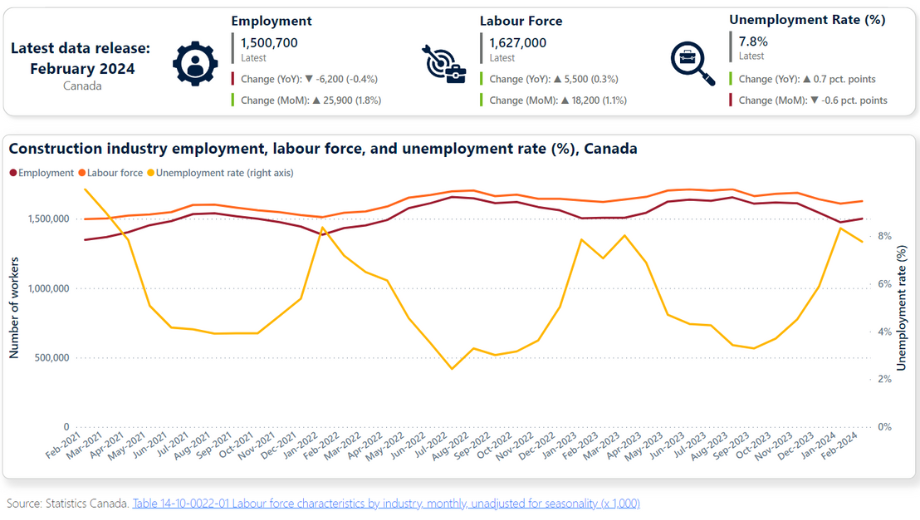Employment figures across the country inched higher in February.
The latest Labour Force Survey (LFS) data from Statistics Canada finds that national, all-industry employment added 41,000 workers (0.2%) in February. This follows a similar-sized increase reported in January. Compared with February 2023, employment grew by 1.8%. Gains were greatest among core-aged (24 to 54 years old) women (0.7%) and core-aged men (0.3%).
The unemployment rate increased 0.1 percentage points to 5.8% in February, offsetting the decline recorded in January. The rate has held relatively steady in recent months, sitting at 5.8% for three of the past four months.
These figures are adjusted for seasonality.
Construction reports employment contractions and labour force growth over the past 12 months
Seasonally unadjusted LFS data finds that construction employment contracted by 0.4%, or -6,200 workers between February 2023 and February 2024. Meanwhile, the industry’s labour force grew by 0.3%, or 5,500 workers. As a result, the industry’s unemployment rate increased from 7.1% in to 7.8% over the year.

Employment gains over the past 12 months were exclusively reported among females (+26,300, +13.5%), and among those in the core working-age group (+19,600, +14.3%) in particular. Employment among males contracted by 32,500 workers (-2.5%) over the year, with the greatest contraction (-28,300 workers, -3.1%) among those in the core-aged group.
Of note, employment increased among both males (+1,600, +9.5%) and females aged 15 to 24 years (+10,200, +7.6%). These trends further confirm the success of industry initiatives to promote careers in the skilled trades to women and young people.
Employment metrics varied across the provinces. Alberta (+19,800, +9.1%), New Brunswick (+5,600, +22.3%), and Manitoba (+4,900, +9.5%) reported the largest year-over-year gains, while British Columbia (-21,100, -8.5%), Ontario (-12,400, -2.2%) and Nova Scotia (-2,300, -6.1%) reported the greatest employment contractions.
These trends held across the various provincial labour forces. Gains were greatest year over year in Alberta (+21,200, +8.9%), New Brunswick (+5,800, +19.2%), and Manitoba (+5,300, +9.8%), while contractions were most pronounced in British Columbia (-17,000, -6.5%), Ontario (-8,100, -1.3%), and Nova Scotia (-3,900, -8.9%).
Many of the employment and labour force increases were the products of the seasonal nature of work in the construction sector. In Alberta’s case, some were also likely driven by the beginning of shutdown/turnaround maintenance activities in the heavy industrial sector. The reported contractions in British Columbia, Ontario and Nova Scotia could be attributed to reduced activity in the provinces’ respective housing sectors.
Industry unemployment rates across the provinces in February 2024 varied from a high of 26.4% in Newfoundland and Labrador to a low of 5.0% in Manitoba. Three provinces reported rates above 10%: Saskatchewan (10.9%), Nova Scotia (11.1%), and New Brunswick (14.7%).

Construction Key Indicators
